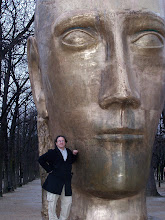This show was designed for the 71st anniversary of Kristallnacht. A German Jewish woman who was 4 years old in Stuttgart shared her remembrances. She reminded me that the Holocaust became the Holocaust later, that most believed that the upsurge in antisemitism in 1930's Germany was not different than other times and would fade. Kristallnact changed that for her father and he got her and their family out of Germany as soon as was possible. I was impressed by the fact that she did not feel proprietary about genocide, noting others targeted by the Nazis and those suffering similar fates since and even now.
The music was chosen to tie into this theme. The Carnegie Mellon Philharmonic was conducted by their new music director, Ronald Zollman. Martinu's Memorial to Lidice began the program. Lidice was a town in Czechoslovakia destroyed by the Nazi's in retaliation for the killing of an SS officer. I did not know this piece though I do have a good deal of Martinu's music. While a heavy piece for Martinu, this still sounded like Martinu to me. This is as it should be I suppose but I did not feel the music captured the horrors the piece was referencing. I was glad to hear Martinu live, which I believe was a first for me.
Erwin Schulhoff's first symphony came next. Schulhoff was a Czech Jew who died in a Nazi concentration camp in 1942. His symphony from 1925 was also new to me. Schulhoff, according to the program notes, was all over the place in terms of influences, Reger, Debussy Schoenberg and Jazz all noted. This piece was also all over the place in a way that I found pretty enjoyable and amusing. I was reminded of early Stravinsky (Petruska), Debussy and Symanowski with a brief mix of serious dissonances and weird percussion effects. There were also these martial sounding percussion moments at the end of movements that seemed like foreshadowing of the war to come. My feeling was that Schulhoff had captured the wildness of 1920's Germany quite well in this piece. The Orchestra presented the music well. I would like to hear it again and will have to look for a recording.
Unlike the first half of the show, the second half was all familiar music. The music was also performed without pauses for applause from the audience. Barber's Adagio for Strings opened. This was my second Adagio in a few weeks as I had just heard the PSO and Leonard Slatkin do it on October 23rd. So how does a student orchestra compare with a world class ensemble? The Carnegie Mellon strings did quite well. The interpretations were quite different. While I didn't time them, I would guess the PSO performance came in at about nine minutes while this performance had to be about 7 minutes (reminded me of a version I have by Leopold Stokowski). It was certainly not as intense of an experience. I wondered about Zollman's choices here: does he just prefer a faster tempo? was the faster tempo due to a student ensemble not being well suited to the slower tempo? or was the choice due to Zollman presenting this as the first "movement" in this half of the program? I don't know but as the last bits of the Adagio were fading, the percussion section was getting ready. Schoenberg's A Survivor from Warsaw could hardly be more different from the Barber Adagio. Survivor is as furious as the Adagio is peaceful and comforting. Zollman went straight in without pause, the trumpet blaring and the percussion ringing loud. The narrator performed from the left box above the orchestra. This was the third time I have heard the "Survivor" live, each time it was an intense emotional experience and this was no exception. As the narrator, Douglas Ahlstedt, finished his last part and the orchestra and percussion reach their frenzied climax, it sent shivers down my spine and the chorus singing the Shema Yisroel brought tears to my eyes. I don't think there is a more intense seven minutes in all of classical music. Again without pause, Zollman started the Mahler Totenfeier (Burial Ceremony). All of us Mahler fans know this better as the music that became the first movement of his Second symphony. I have read that the differences are many but slight. I can't say that I could pick out any of them. While this piece probably presented the orchestra with it's most difficult challenges and they did sound at times like a very good student orchestra, this was a great choice for end of this program. Zollman was incisive without being rushed. It allowed me to recover my equilibrium after the Schoenberg.
As I noted in writing about Jennifer Koh's recital, a well designed program ends up being greater than the sum of it's parts. While the Barber was a bit of a stretch in terms of the historical tie in, it was perfect as a musical emotional set up of what came after. The CM Philharmonic brought things off well, while not achieving technical perfection they delivered a great concert. I thought Douglas Ahlstedt was spot on as the narrator in the Schoenberg, my favorite of the three performances I have seen.
Subscribe to:
Post Comments (Atom)

No comments:
Post a Comment